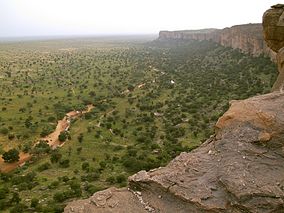Bandiagara Escarpment
| Bandiagara Escarpment (Cliffs of Bandiagara) | |
|---|---|
|
IUCN category III (natural monument or feature)
|
|

The Bandiagara Escarpment from Banimoto
|
|
| Location | Mopti Region, Mali |
| Coordinates | 14°13′55″N 3°29′17″W / 14.231845°N 3.487967°WCoordinates: 14°13′55″N 3°29′17″W / 14.231845°N 3.487967°W |
| Area | 4,000 km2 (1,500 sq mi) |
| Established | 1985 |
| Official name | Cliff of Bandiagara (Land of the Dogons) |
| Type | Mixed |
| Criteria | v, vii |
| Designated | 1989 (13th session) |
| Reference no. | 516 |
| State Party |
|
| Region | Africa |
The Bandiagara Escarpment is an escarpment in the Dogon country of Mali. The sandstone cliff rises about 500 meters above the lower sandy flats to the south. It has a length of approximately 150 kilometers.
The area of the escarpment is inhabited today by the Dogon people. Before the Dogon, the escarpment was inhabited by the Tellem and Toloy peoples. Many structures remain from the Tellem. The Bandiagara Escarpment was listed in the UNESCO World Heritage List in 1989.
The Cliffs of Bandiagara are a sandstone chain ranging from south to northeast over 200 km and extending to the Grandamia massif. The end of the massif is marked by the Hombori Tondo, Mali's highest peak at 1,115 meters. Because of its archaeological, ethnological and geological characteristics, the entire site is one of the most imposing in West Africa.
The cave-dwelling Tellem, an ethnic group later pushed out by the arrival of the Dogons, used to live in the slopes of the cliff. The Tellem legacy is evident in the caves they carved into the cliffs so that they could bury their dead high up, far from the frequent flash floods of the area.
Dozens of villages are located along the cliff, such as Kani Bonzon. It was near to this village that the Dogons arrived in the 14th century, and from there they spread over the plateau, the escarpment and the plains of the Seno-Gondo.
According to local oral history, the Dogon were relatively undisturbed by the French colonial powers due to the existence of a series of natural tunnels weaving through the Bandiagara Escarpment, which only the Dogon know about, and thus were able to use these caves to surprise and drive away any aggressors.
Today, local guides can take tourist groups on trips along the escarpment to visit the Dogon villages. A series of trails runs along the cliffs, and hostels in each village provide food and lodging. The host villages receive income from the hostels and the tourist tax. Large increases in tourism to the area are expected, as a new highway is constructed, putting pressure on local, traditional cultures. In addition, The Independent reports that looting of ancient artifacts is widespread in the area, which is poorly policed.
...
Wikipedia
